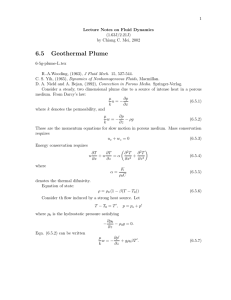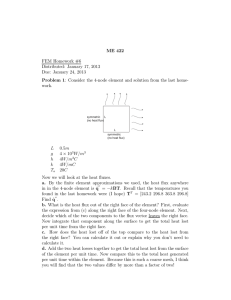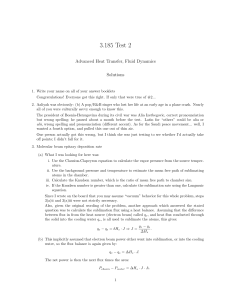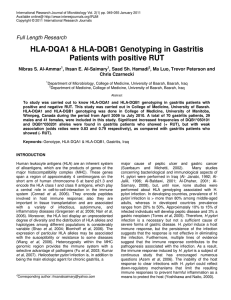4.4 Buoyant plume from a steady heat source
advertisement
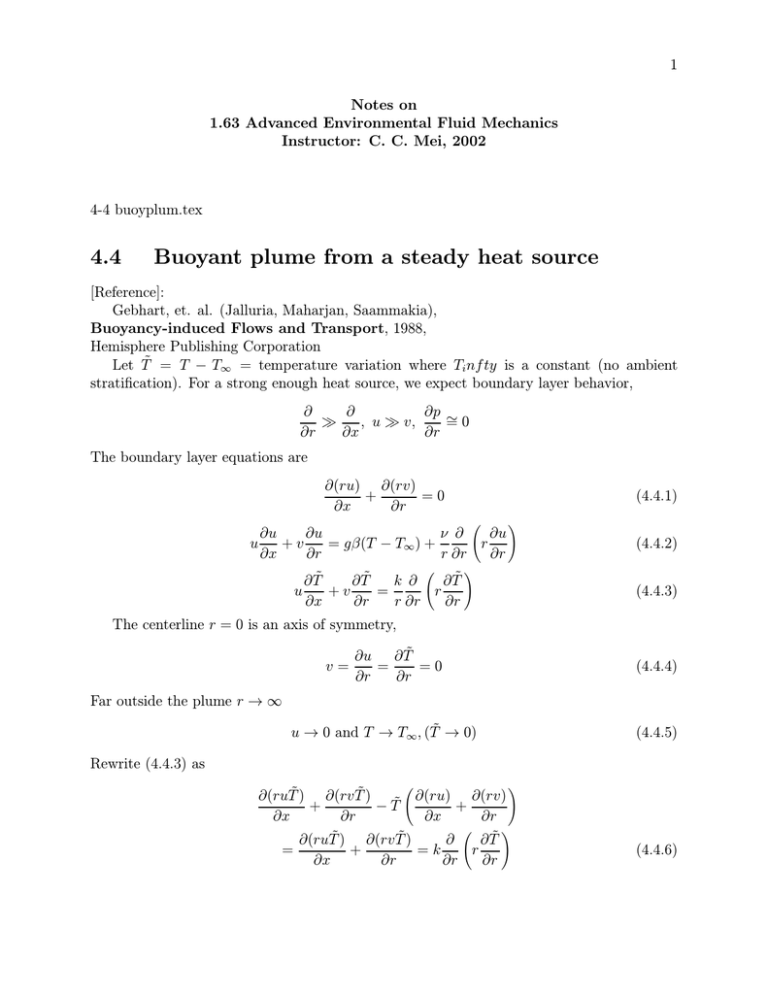
1 Notes on 1.63 Advanced Environmental Fluid Mechanics Instructor: C. C. Mei, 2002 4-4 buoyplum.tex 4.4 Buoyant plume from a steady heat source [Reference]: Gebhart, et. al. (Jalluria, Maharjan, Saammakia), Buoyancy-induced Flows and Transport, 1988, Hemisphere Publishing Corporation Let T̃ = T T = temperature variation where Ti nf ty is a constant (no ambient stratification). For a strong enough heat source, we expect boundary layer behavior, ( (p ( À , u À v, =0 (r (x (r The boundary layer equations are ((ru) ((rv) + =0 (x (r (4.4.1) à " ( (u (u (u u r +v = g#(T T ) + (x (r r (r (r à ( T̃ ( T̃ k ( ( T̃ u +v = r (x (r r (r (r ! (4.4.2) ! (4.4.3) The centerline r = 0 is an axis of symmetry, v= (u ( T̃ = =0 (r (r (4.4.4) Far outside the plume r u 0 and T T , (T̃ 0) (4.4.5) Rewrite (4.4.3) as ((ruT̃ ) ((rv T̃ ) + T̃ (x (r à ((ru) ((rv) + (x (r à ((ruT̃ ) ((rv T̃ ) ( ( T̃ = + =k r (x (r (r (r ! ! (4.4.6) 2 after using continuity. Now integrating the last equation from r = 0 to r = Z ( Z ((rv T̃ ) dr 2$ruT̃ dr + 2$ (x 0 (r 0 à ! Z ( ( T̃ = k2$ dr r (r (r 0 Therefore ¯ à ¯ ( Z ( T̃ ¯ 2$ruT̃ dr + 2$rv T̃ ¯¯ = 2$k r (x 0 (r 0 !r= (4.4.7) r=0 Using the boundary conditions, we get or Z 0 2$ruT̃ dr = constant Note that Z 0 2$rdr u'C T̃ = rate of buoyancy flux = rate of heat flux = Q(given rate of heat release at x = 0) Therefore, Z Q= 2$rdr'uC T̃ 0 (4.4.8) This is a boundary condition. Let the stream function be defined by ru = ( , (r rv = ( (x (4.4.9) (4.4.1) is automatically satisfied. From the momentum equation: à 1 ( r (r ! 1 (2 1 ( ( r (x(r r (x (r à 1 ( r (r ! " " ( ( = g# T̃ + r r (r (r à 1 ( r (r !# (4.4.10) From the energy equation à 1 ( ( T̃ 1 ( ( T̃ k ( ( T̃ = r r (r (x r (x (r r (r (r ! (4.4.11) and from the buoyancy flux condition Z Q = 2$'C 0 à ! 1 ( rdr T̃ r (r (4.4.12) 3 Try a similarity solution with the one-parameter transformation x a x , From (4.4.10), r = b r , = c , T̃ = d T 2c4ba = 2c4ba = d = c4b (4.4.13) c+d2ba = d2b (4.4.14) c+d = 1 (4.4.15) from (4.4.11) and from (4.4.12) From these three equations we get b 1 d c = 1, = , = 1. a a 2 a Th similarity variable can be taken to be = r x1/2 (4.4.16) and the similarity solution to be = xF () (4.4.17) T̃ = x1 G() (4.4.18) and After a lot of algebra, and noting ( 1 ( 1 r 1 r 1 = 1/2 , = 3/2 = 1/2 = (r x (x 2x 2x x 2x we get from (4.4.10) à F0 "F + 000 and from (4.4.11) !0 (F ") + g#G = 0 k(G0 )0 + (F G)0 = 0 (4.4.19) (4.4.20) . Before integrating, let us normalize : = ¯ , F = F̄ , G = Ḡ. (4.4.21) It follows from (4.4.19) that " 000 F̄ + 3 3 à F̄ 0 ¯ !0 ( F̄ ") + g#¯ Ḡ = 0 (4.4.22) 4 where prime denotes d/d¯ . Setting = " and "2 = g# 3 which relates and , = we get à F̄ 0 F̄ + ¯ 000 "2 g#4 (4.4.23) !0 (F̄ 1) + ¯Ḡ = 0 (4.4.24) Similar normalization of (4.4.20) gives k 0 0 (F̄ Ḡ)0 = 0 (¯ Ḡ ) + 2 (4.4.25) (¯ Ḡ0 )0 + P r(F̄ Ḡ)0 = 0 (4.4.26) . which can be simplified to . where " = Prandtl Number (4.4.27) k For water " = 102 cm2 /s, k = 1.42cm2 /s, hence P r = 7. For air " = 0.145cm2 /s, k = 0.202cm2 /s, hence P r = 0.75. We now integrate (4.4.26)to give Pr = ¯Ḡ0 + Pr F̄ Ḡ = constant Since (x, 0) = 0, we must have F̄ (0) = 0 ; the constant above is zero. ¯Ḡ0 + Pr F̄ Ḡ = 0 (4.4.28) Equation (4.4.28) can be written F̄ F̄ Ḡ0 d ln Ḡ = Pr , or = Pr Ḡ ¯ d¯ ¯ Z ln Ḡ = Pr 0 ¯ F̄ d¯ + constant ¯ à Ḡ(¯ ) = Ḡ(0) exp Pr Z 0 ¯ ! F̄ d¯ ¯ (4.4.29) Substituting Eqn. (4.4.29) into Eqn. (4.4.24), the resulting equation for F̄ must be integrated numerically. Now let us find the boundary condtions for F or F̄ . 5 Eqn. (4.4.8 ) becomes à Z Q 1 ( = dr r 2$'C r (r 0 ! Z G() Z G Z r = dr x1/2 F 0 = d(F 0 G) = " d¯ (F̄ 0 Ḡ) x r x 0 0 0 (4.4.30) Therefore, Z 0 d¯ F̄ 0 Ḡ = Let us choose Q 2$'C" (4.4.31) Q =1 2$'C" so that Z (4.4.32) d¯ F̄ 0 Ḡ = 1 0 (4.4.33) is the boundary condition for F̄ and Ḡ. Now (4.4.32) defines , the scale of G. Note that larger Q implies larger and smaller . Thus a stronger heat source leads to a greater centerline temperature and a thinner plume. Also, u 0 as r hence F0 1 " F̄ 0 = 2 0, as ¯ u = r = r ¯ The radial velocity is, in general à 1 F0 1 F v = x = r r 2 ! Since v0 as 0, we must have, F (0) = 0. Clearly F̄ 0 0, and F̄ (¯ ) = 0 as ¯ 0 ¯ (4.4.34) The numerical results by Mollendorf & Gelhart, 1974, are shown in Figs. 4.4.1, for various Prandtl numbers. A schlierian photograph due to Gebhart (copied from Van Dyke An Album of Fluid Motion) is hown in Figure fig:plumeVD. Remark: µ ¶ 1 ( 1 F0 x u= = = F 0 1/2 r (r r x 6 ³ 0 ´ Along the centerline u(x, 0) = F = constant depending on Pr . Why? Buoyancy acceler0 ation is counteracted by entrainment. Remark: Let the radius of the plume be a which varies as a x1/2 This is consistent with the behavior that u x0 , and T̃ x1 , since a2 uT̃ = Q On the other hand the mass flux rate is ua2 x and the momentum flux rate is u2 a2 x hence both approach zero at the source. Thus a plume is the result of energy source, not of mass or momentum.

